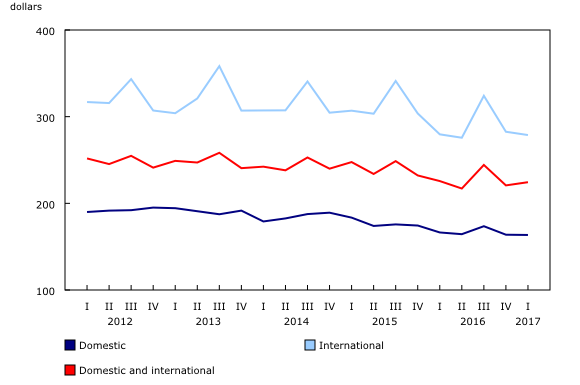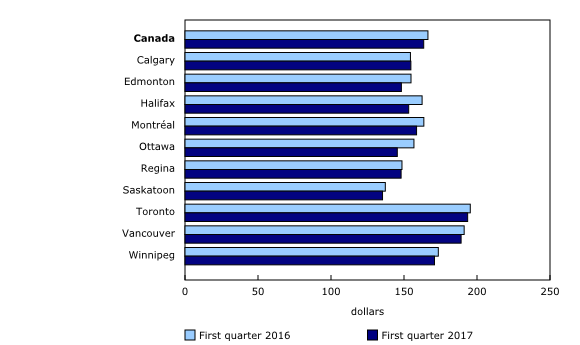Air fares, first quarter 2017
Archived Content
Information identified as archived is provided for reference, research or recordkeeping purposes. It is not subject to the Government of Canada Web Standards and has not been altered or updated since it was archived. Please "contact us" to request a format other than those available.
Released: 2017-11-01
$224.40
First quarter 2017
-0.6% 
(year-over-year change)
Base air fares in Canada, domestic and international combined, averaged $224.40 in the first quarter, down 0.6% from the same quarter in 2016 and continuing the downward trend that began in the second quarter of 2015. Base air fares do not include taxes and user fees.
The average domestic fare was down 1.7% from the first quarter of 2016 to $163.50, while the average international fare edged down 0.3% to $278.80.
Average domestic fares declined in 9 of the 10 selected Canadian cities of enplanement, with Ottawa (-7.3%), Halifax (-5.7%) and Edmonton (-4.3%) recording the largest decreases. Calgary (+0.2%) was the lone city to post an increase.
Toronto ($193.60) remained the city with the highest average domestic air fare, followed by Vancouver ($189.10) and Winnipeg ($170.90). These were the only three cities to record average domestic fares above the national average. Meanwhile, Saskatoon ($135.30) posted the lowest average domestic air fare for a 10th consecutive quarter.

In celebration of the country's 150th birthday, Statistics Canada is presenting snapshots from our rich statistical history.
On September 1, 1937, Canada's first national airline, Trans-Canada Air Lines, kicked off its passenger operations. Using its new Lockheed Electra aircraft and carrying two passengers, it flew its first regular service on a route between Vancouver and Boeing Field, Seattle, in 50 minutes. The air fare was $7.90 one way and $14.20 return.
The following year, regulation was introduced in an effort to protect the airlines. This regulatory oversight of fares continued essentially unchanged until 1984, when Canada began taking steps to open the air travel market to competition, culminating in the 1987 National Transportation Act.
After accounting for general price increases or inflation, the desired effect of these regulatory reforms appeared to be minimal at first, with air fares increasing slightly until 2000.
Since then, average base fares have fallen steadily, due not only to increased competition, but also to the unbundling of ticket prices into a lower base fare and supplementary charges (airport improvement fees, meals, checked bags), and, more recently, due to lower prices for jet fuel.
Note to readers
Average air fares are base fares and do not include the goods and services tax, air transportation taxes or user fees, such as airport improvement fees or fuel surcharges.
Average air fares are calculated for each flight stage. When the passenger boards the aircraft at one airport and departs the aircraft at another airport, this is considered a flight stage.
The Fare Basis Survey covers Air Canada (including Air Canada rouge), Jazz, Air Canada's Canadian regional code-share partners, Air Transat and WestJet.
The data in this quarterly release are not seasonally adjusted.
The Fare Basis Survey is being redesigned.
Products
Summary tables are also available.
Contact information
For more information, contact us (toll-free 1-800-263-1136; 514-283-8300; STATCAN.infostats-infostats.STATCAN@canada.ca) or Media Relations (613-951-4636; STATCAN.mediahotline-ligneinfomedias.STATCAN@canada.ca).
For more information on the current definitions, data sources and methods of the Fare Basis Survey, click on the Related information tab of this release. Readers who wish to know more, or to consult with Statistics Canada about the redesign of this survey can also contact (statcan.transportationstats-statistiquesdutransport.statcan@canada.ca).
- Date modified:



